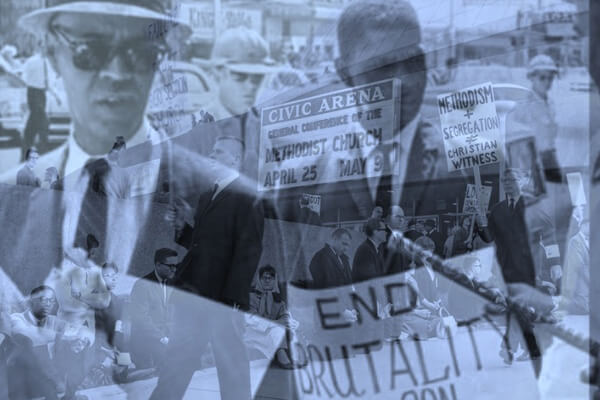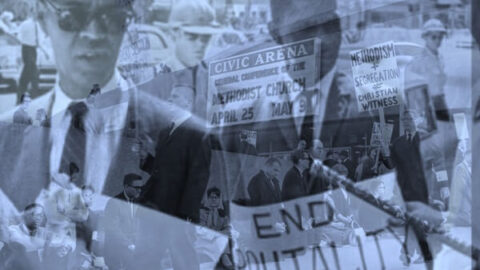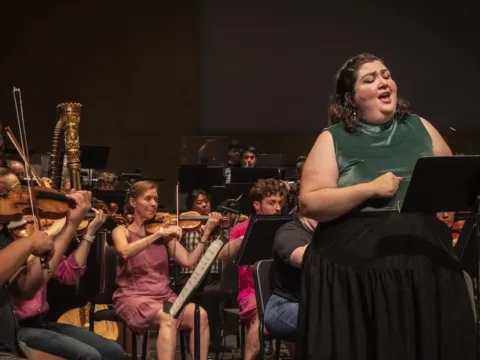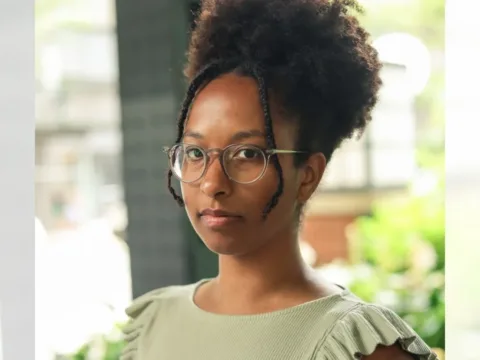Something quite remarkable is happening in Chicago. Equal parts drama, music, history, and social activism, it’s The March: A Civil Rights Opera, a project currently in development by librettist Alan Marshall and composer Jonathan Stinson. While still seeking a commission from an opera company, they are developing their own production and presenting excerpts to help raise funds and foster awareness of the project. We attended one of these events at the Chicago Temple on September 29, 2012, which featured excerpts from The March accompanied by a nine-piece chamber ensemble. Prior to the opera selections, they presented Mass Meeting 2.0, a dramatization of such meetings held during the height of the U.S. civil rights movement, which was effective in setting the stage for the opera. After attending the event, we also had the opportunity to talk at some length with both Marshall and Stinson. Explaining his zeal for the project, Marshall says “I am producing this opera to celebrate a seminal moment in American history and the struggle for racial equality and social justice, and, equally important, to provide leading role opportunities for highly-trained African American opera singers.”

The March tells the story of the 1963 “March on Washington for Jobs and Freedom” at which Martin Luther King made his famous “I Have a Dream” speech. When complete, it will weave together three story lines. One follows the African American leaders, another covers the Washington political scene vis-à-vis civil rights, and the third follows Leila Patterson, a young white southern woman from a segregationist family, who joins the civil rights movement. The opera will unfold in both public and private settings. Much of the dialogue for public scenes will be drawn from historical reports of the events. The scenes behind closed doors “will reach more into the characters’ souls and raw humanity, expressing doubts and vulnerability in even the strongest of them,” Marshall said. “The March is not a documentary, but we are using history to delve into the dramatic personal lives of real human beings in this pivotal moment of American history.”
The complete opera is being scored for a 52-piece orchestra. According to Stinson, his core compositional aesthetic is to put the music at the service of the dialogue, to ensure that the story can be told in a well-articulated manner by the singers. The score will fit well into the established cannon of 20th century dramatic opera derived from the Romantic tradition of composers such as Giacomo Puccini. Stretching beyond this foundation, the music for each of the story threads will have its own unique character, capturing music that reflects the times. For the African American leadership storyline, Stinson is incorporating freedom songs, gospel themes, and jazz. The jazz element will be highlighted throughout the score by music for alto saxophone. Music for the White House scenes will be big and egotistical to represent the Washington, D.C. personalities. “The profile for Leila’s music is more personal and introspective, highlighting her idealism,” says Stinson. “It is similar in style to the music Aaron Copland created to celebrate America’s rural folk music traditions.”
The first opera selection presented was “The Oval Office,” pitting the advocates for civil rights legislation, John Kennedy, Lyndon Johnson and Robert Kennedy, against three southern senators. They argue over whether to allow the march or to attempt to stop it. The senators are all are staunch segregationists. The South had failed in the Civil War to prevent the end of black slavery; this voting bloc had been fighting since the end of Reconstruction to preserve white privilege. Tenor Scott Brunscheen’s singing as JFK was bold and assertive, displaying Kennedy’s confidence that he would win this battle eventually. Behind closed doors, Stinson explained how the music will change. “John and Robert Kennedy are more playful as they drop the armor and shields,” he said. “As John reflects on his legacy and dreams for the country in his aria ‘How Will I Be Remembered,’ the music is romantic and Puccini-like.” This should evoke a bittersweet poignancy, given that JFK would be assassinated in Dallas only three months later.
The second excerpt, “Civil Rights Meeting,” presented a pivotal gathering of African American leaders debating the question of whether a large march will actually further the cause of justice and equality. The characters include Roy Wilkins (long time president of the NAACP, representing the conservative approach toward change using legislation), John Lewis (chairman of SNCC, the Student Nonviolent Coordinating Committee, pushing a more militant agenda), A. Phillip Randolph (leader of the Brotherhood of Sleeping Car Porters, the first Black labor union), and, of course, Martin Luther King. The tension in the scene was palpable as longtime standard bearers are challenged by young, articulate leaders who are tired of the “go slow” approach. Martin Luther King’s aria is this scene, ably sung by baritone Martin L. Woods, represents the changing of the guard in leadership of the African American community. “Music for this aria,” said Stinson, “captures the milieu of it’s day, incorporating jazz themes in the alto saxophone part.” A private scene in this story thread will feature King expressing his doubts about the march and his role in it to his wife Coretta.
Photos courtesy of The March: A Civil Rights Opera project. All rights reserved.
In the final opera excerpt, Emmitt Till, who was lynched in Money, Mississippi in 1955, appears as a ghost during the African American leaders meeting. In a stunning aria entitled “March For Me,” Tenor Anthony McGlaun was accompanied by clarinetist Cory Tiffin playing what will become an alto saxophone part in the finished score.This was the musical highlight of the evening for us and its deep emotional expression brought tears to our eyes.
No opera material related to the Leila Patterson story was presented, but her character was integrated into Mass Meeting 2.0. Leila’s story will include Leila’s grandfather, a former Ku Klux Klan member, her father, a member of the local White Citizens Council (aka “the businessman’s KKK”), her brother Ray, a hot head who likes to crack heads, and her mother, who just wants to protect her daughter. Leila participates in lunch counter sit-ins and meets important leaders of the student movement, SNCC. She must choose between being disowned by her family and her new views of justice and equal rights. “Leila’s music will reflect her idealism and perhaps naiveté about what she is actually getting herself into,” says Stinson.
Mass Meeting 2.0 contained no composed music, but its re-enactment of meetings typical for the era provided important historical context and emotional background for the opera. It introduced key historical characters such as Medgar Evers, Stokely Carmichael, Anne Moody, Rev. Ed King, and Roy Wilkins. Marshall constructed this scene with many of the actors sitting among the audience. This immersive experience was highly effective in drawing the crowd into the story. During the meeting, a group of SNCC students, including Leila, challenged the old line leadership and their dated methods. By chance, the SNCC group sat right in front of us, which turned out to be quite serendipitous for Arlene, who was a SNCC worker in Arkansas in 1964-65. We were wowed by the level of authenticity this presentation conveyed. Wisely, Marshall plans to present a version of Mass Meeting whenever the opera is performed.
Marshall and Stinson hope to complete a concert version of The March in time for the 50th anniversary of “The March on Washington” next August. In the meantime, they will continue presenting supporting events. The next of these will be Civil Rights Movements, a benefit performance in collaboration with the Chicago-based Joel Hall Dancers on November 10, 2012. This program will feature singers and dancers performing to music from the opera. Additional presentations of opera excerpts and Mass Meeting 2.0 are also planned for Charlotte, North Carolina, and Columbus, Ohio, in the coming months. More information can be found at: http://www.civilrightsopera.com/.
























